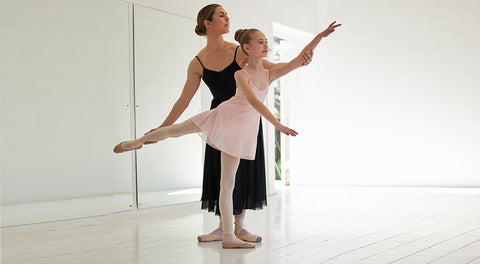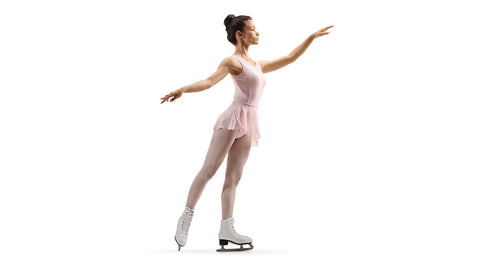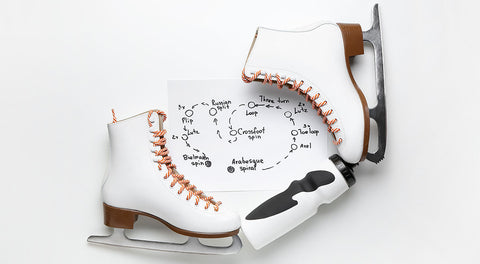Ice Rink Rental vs Purchase: Which is Better for Your Business?
JimIce skating is a timeless practice.
It’s not unusual to see kids as young as four or adults in their seventies sliding across a neighborhood rink.
Skating reaches fever pitch when the winter months come along, with hundreds of people attending the most prominent ice rinks in the world daily.
Despite its popularity, the availability of ice rinks has been a growing concern.
ADD SYNTHETIC ICE TO YOUR RENTAL INVENTORY WITH POLYGLIDE SYNTHETIC ICE

As a result, incorporating ice rinks into various businesses has become a trend both temporarily during the winter or permanently to meet the year-round demand for ice skaters.
Common businesses interested in ice skating rinks include:
- Hotels
- Museums
- Malls
- Carnivals and Amusement Parks
- Gaming/Entertainment Businesses (Think Dave and Busters)
- Party Rentals
- Event Planners
Some businesses are invested in skating and have stand-alone rinks with all the coaches, equipment, and facilities needed to succeed.
Whether you are considering adding an ice rink to attract more customers or looking to use it as an additional stream of income, the decision between renting and purchasing is critical for the long-term success of your venture.
We’ll explore the pros and cons of ice rink rental vs purchase and the special advantages you get from choosing a synthetic ice surface as your rink of choice.

What are Your Business Needs?
Before deciding to rent or buy an ice rink, we must explore two areas:
- The type of ice rink you’re renting/buying
- The needs and goals of your business
Understanding Ice Rink Types
The underlying concept of an ice rink is the use of metal blades (skates) to move across a thin sheet of ice.
The first ice rinks were frozen lakes, ponds, and other bodies of water.
The cold winter temperatures allowed these spaces to freeze, making ice skating possible.
Today, you can produce your own outdoor ice-skating rinks using the same concept and a few simple supplies from a hardware store.
Eventually, we perfected the art of refrigeration.
Using water, a special coolant, and refrigeration machines, we can constantly keep the coolant at low temperatures.
The coolant creates ice by freezing the water.
Refrigerated ice rinks are popular in most indoor rinks, figure skating spaces, and the NHL.
There’s also a third option in synthetic ice.
Using unique panels made of durable polyethylene plastics, you can connect them on a flat surface to make your own rink.
Infusing the synthetic ice tiles with a slip surface agent helps create a fantastic ice-skating experience.
Its durability and versatility also afford the user several advantages.
The right ice rink type plays a major role in how it can support your business long-term.
Your Business Needs and Goals
How can an ice rink support or enhance your business?
For some business owners, the rink can do wonders for customer experience or customer engagement.
For instance, the rink in a mall may encourage customers to stay longer and create an unforgettable memory.
This improved customer experience translates into word-of-mouth marketing and future visits.
In other cases, it can be a unique activity that separates your business from your competitors.
If someone searches for an ice rink online or on social media and your business comes up, you’re more likely to get that sale.
Ice rinks also add rental and participation income to any business.
Some businesses rent out ice rinks to other spaces for parties, events, and other private functions.
Others charge a flat fee during the holidays for participants to skate for a specific timeframe.
Whatever the reason, owning an ice rink is an investment that pays off over time.
If you’re choosing ice rink rental vs purchase, consider factors like the preferences of your target audience and the frequency and duration of ice rink usage.
Will it be seasonal or year-round?
The right option should align with your budget and strategic goals.
Should You Rent? Pros and Cons

Ice rink rental is a standard option for most businesses.
You’ll pay a supplier a monthly fee, who will then set up and maintain the rink.
Rentals are popular for refrigerated ice rinks but can be done for synthetic and natural ice rinks as well.
Some of the advantages of rentals include:
- Initial Cost Savings: Large ice rinks can be a significant upfront investment. If your business is operating on a tighter budget, but you see the value in having an ice rink, a rental is a significant advantage. You can leverage the rink to increase your income without the large upfront commitment.
- You’re Not Responsible For Maintenance: Ice rinks require constant maintenance, especially if hundreds of people are using them daily. For a rental, the maintenance time and expertise usually fall on the owner of the ice rink. The business will pay a flat maintenance fee.
- Flexibility in Rink Size: Need a larger rink? Talk to the rental company. Need to downsize? They can help, too. Once you buy a rink, you’re stuck with the size if you soon realize you need a larger space. Renting a rink allows you to speak with the rental company to get the changes you need sooner rather than later.
There are some cons with ice rink rental. These include:
- Long-Term Cost Implications: In the short term, rentals are fine, especially if the ice rink is purely seasonal. However, the long-term costs can add up if you want the rink indefinitely. Over time, recurring rental fees can accumulate, potentially surpassing the cost of purchasing an ice rink outright. If an ice rink is part of your long-term plans, you may need to weigh the long-term costs of rentals versus investment.
- A Lack of Customization: If you’re renting, you’re probably limited to the choices near you. These providers may not have the quality or special options you need. The rink may not align with your standards or aesthetics.
- Dependency on Rental Availability: In the later months of the year, the demand for ice rinks rises significantly. If you’re slow on the uptake, you may miss out on landing a high-quality rink for your space. This can impact your ability to provide a unique ice-skating experience, or you may need to opt for an inferior alternative, leading to bad customer uptake over time.

Buying Your Rink Outright: Pros and Cons
Some businesses, like amusement parks, malls, and entertainment businesses – may want to purchase their rinks outright.
They see an ice rink as a core part of their service offerings and have the disposable income/credit to do so.
If you fall under this category, here are the pros and cons of ice rink rental vs purchase:
Pros:
- A Viable Asset: When you look at the assets and liabilities of your business, an owned ice rink falls into the asset category. As it continues to make you money through events or everyday patrons, it starts paying you back almost immediately.
- Lower Long-term Maintenance Costs: You’ll be responsible for maintaining the rink. However, the cost and efficiency of maintenance reduce over time, saving you valuable time and money.
- You Can Use It After Winter: Owning a rink means you aren’t limited to the cold winter months. Indoor refrigerated rinks can run throughout the year. Synthetic ice rinks can be operated indoors and outdoors. Your investment is not limited to the peak seasons.
- Do it Your Way: When you purchase your rink, you have the autonomy to design and brand it as you see fit. This can help you attract more customers, add exciting options like Curling, and provide additional services if you’re renting out your rink to groups.
Cons:
- An Initial Higher Investment: An ice rink capable of handling hundreds of skaters daily can cost tens of thousands of dollars. Of course, you should weigh the pros and cons of investment, but understand this can be a large upfront investment. If you’re struggling with cash flow, you expose yourself to trouble if something unexpected occurs. You may also need to invest in rental ice skates, skating aids, and attendants. Take all these costs into account before pulling the trigger.
- You Need to Handle Maintenance: Rinks need periodic maintenance to ensure they run smoothly. Refrigerated rinks, for instance, need to be resurfaced almost daily depending on how many people are ice skating. Over time, maintenance can be challenging and costly.
Limited Flexibility: Making changes to the size or design of the ice rink becomes more challenging.
With rentals, you can negotiate these changes and get a response almost immediately.
You’ll need to budget well in advance when opting for a purchase.

Synthetic Ice May Be a Game-Changer
Whether renting or buying, synthetic ice may be the best choice for businesses to get maximum benefit.
In fact, a synthetic ice rink may help reduce many of the disadvantages of ice rink rental vs purchase.
It’s a compelling alternative for businesses looking to get all the benefits of owning an ice rink without the downsides.
- Renting or purchasing a synthetic ice rink is cheaper than other rinks over time.
- It’s easy to set up. Most can be done in a few hours.
- You have indoor and outdoor use throughout the year
- You can increase or decrease the size or change the shape of the rink with ease.
- With a few simple cleaning items, you can maintain the rink. There is no need to hire highly skilled workers.
- Synthetic ice is more forgiving on slips and falls, reducing the chances of injury to skaters.
- Synthetic ice is an environmentally sustainable option. You save power and water and reduce your ecological footprint.
While there is slightly more friction on synthetic ice than on a refrigerated ice rink, the beginner skater will not notice the difference.
Despite the advantages, it’s vital that you acquire high-quality synthetic ice panels that are durable, consistently thick, and have a solid core construction, allowing them to be used on both sides.
The PolyGlide Pro Glide Panel, for instance, is an excellent option for commercial use, lasting several years with even continuous, intensive use.
Conclusion
An ice rink is an excellent option for businesses looking to add value, another income stream, or dive into the ice skating niche.
Rinks can be expensive and need constant maintenance, so choosing ice rink rental vs purchase is vital.
While renting can get you started sooner with fewer upfront costs, purchasing is a long-term plan that can be lucrative in the future.
Make the right choice based on budget, available space, expected traffic, and overall needs.
More importantly, choose an option, like synthetic ice, to give you all of the benefits with minimal downside.
With the flexibility, ease of installation, and durability in mind, choosing to buy a rink will be a no-brainer.
Check out some rink options you may want to consider for your event at PolyGlide Ice.


























